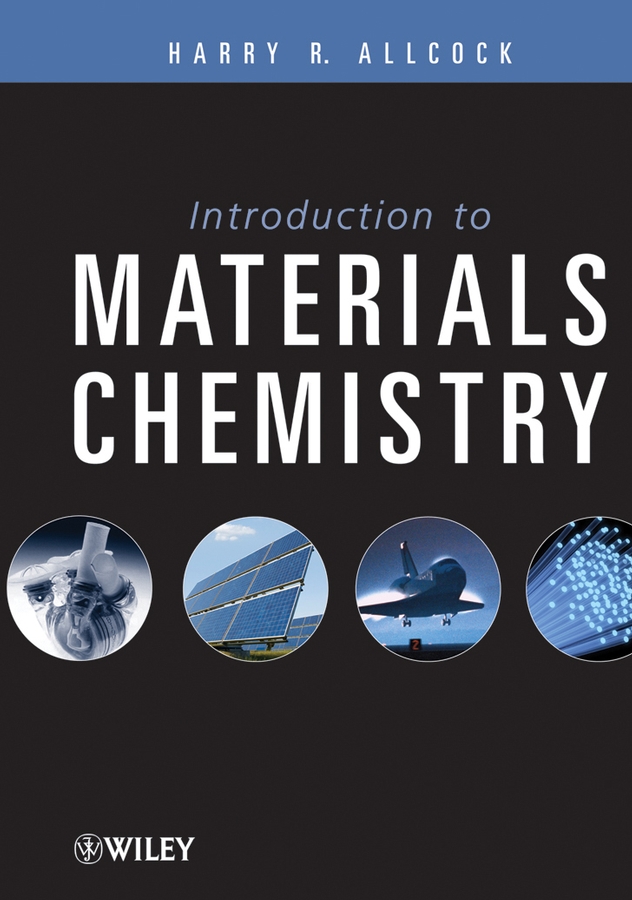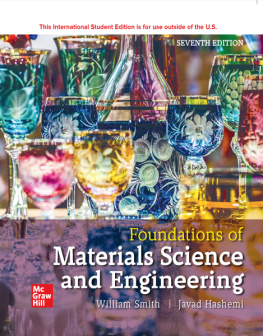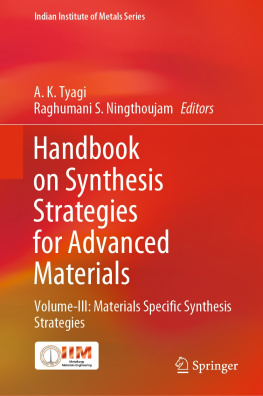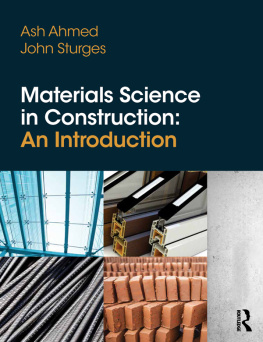Harry R. Allcock - Introduction to Materials Chemistry
Here you can read online Harry R. Allcock - Introduction to Materials Chemistry full text of the book (entire story) in english for free. Download pdf and epub, get meaning, cover and reviews about this ebook. year: 2008, publisher: Wiley, genre: Children. Description of the work, (preface) as well as reviews are available. Best literature library LitArk.com created for fans of good reading and offers a wide selection of genres:
Romance novel
Science fiction
Adventure
Detective
Science
History
Home and family
Prose
Art
Politics
Computer
Non-fiction
Religion
Business
Children
Humor
Choose a favorite category and find really read worthwhile books. Enjoy immersion in the world of imagination, feel the emotions of the characters or learn something new for yourself, make an fascinating discovery.

- Book:Introduction to Materials Chemistry
- Author:
- Publisher:Wiley
- Genre:
- Year:2008
- Rating:4 / 5
- Favourites:Add to favourites
- Your mark:
- 80
- 1
- 2
- 3
- 4
- 5
Introduction to Materials Chemistry: summary, description and annotation
We offer to read an annotation, description, summary or preface (depends on what the author of the book "Introduction to Materials Chemistry" wrote himself). If you haven't found the necessary information about the book — write in the comments, we will try to find it.
Introduction to Materials Chemistry — read online for free the complete book (whole text) full work
Below is the text of the book, divided by pages. System saving the place of the last page read, allows you to conveniently read the book "Introduction to Materials Chemistry" online for free, without having to search again every time where you left off. Put a bookmark, and you can go to the page where you finished reading at any time.
Font size:
Interval:
Bookmark:

Copyright 2008 by John Wiley & Sons, Inc. All rights reserved
Published by John Wiley & Sons, Inc., Hoboken, New Jersey
Published simultaneously in Canada
No part of this publication may be reproduced, stored in a retrieval system, or transmitted in any form or by any means, electronic, mechanical, photocopying, recording, scanning, or otherwise, except as permitted under Section 107 or 108 of the 1976 United States Copyright Act, without either the prior written permission of the Publisher, or authorization through payment of the appropriate per-copy fee to the Copyright Clearance Center, Inc., 222 Rosewood Drive, Danvers, MA 01923, (978) 750-8400, fax (978) 750-4470, or on the web at www.copyright.com. Requests to the Publisher for permission should be addressed to the Permissions Department, John Wiley & Sons, Inc., 111 River Street, Hoboken, NJ 07030, (201) 748-6011, fax (201) 748-6008, or online at http://www.wiley.com/go/permission.
Limit of Liability/Disclaimer of Warranty: While the publisher and author have used their best efforts in preparing this book, they make no representations or warranties with respect to the accuracy or completeness of the contents of this book and specifically disclaim any implied warranties of merchantability or fitness for a particular purpose. No warranty may be created or extended by sales representatives or written sales materials. The advice and strategies contained herein may not be suitable for your situation. You should consult with a professional where appropriate. Neither the publisher nor author shall be liable for any loss of profit or any other commercial damages, including but not limited to special, incidental, consequential, or other damages.
For general information on our other products and services or for technical support, please contact our Customer Care Department within the United States at (800) 762-2974, outside the United States at (317) 572-3993 or fax (317) 572-4002.
Wiley also publishes its books in a variety of electronic formats. Some content that appears in print may not be available in electronic formats. For more information about Wiley products, visit our web site at ww.wiley.com.
Library of Congress Cataloging-in-Publication Data is available.
Allcock, Harry R.
Introduction to Materials Chemistry
ISBN: 978-0-470-29333-1
Preface
Modern undergraduates and graduate students are keenly interested in the various ways in which chemistry impacts everyday life. This interest stems partly from career imperatives, but also from a natural interest in the relationship between fundamental science and the technology that increasingly dominates our lives. Classical chemistry courses at the university level rightly emphasize fundamental science. But courses that focus on the utilization of that chemistry are still rare.
This book is an outgrowth of a course in materials chemistry that I have taught for several years in the Chemistry Department at The Pennsylvania State University. It is a course taken by advanced undergraduates and by students who are in the first year of the graduate program in chemistry, most of whom have had little or no prior exposure to materials science. The class has also attracted undergraduates from materials science and chemical engineering programs who are seeking a general overview of the field. The subject matter is wide-ranging and, because the course extends over only one semester, the treatment aims for breadth, understanding, and perspective rather than great depth. The mathematical foundations of the field are deliberately excluded in order to emphasize chemical concepts rather than the traditional engineering or physics treatments. A challenge with this approach is that published material relevant to this subject is widely scattered in specialist books and research articles, and this presents a problem for students who seek to access background reading material. Thus, I have written this book in order to present a qualitative overview of relevant chemistry-related aspects and to provide a springboard to encourage readers to delve deeper into specific topics.
The book begins in Part I with an overview of the elementary chemistry that underlies much of modern materials science. Chapter 1 is a general introduction to the subject, Chapter 2 deals with descriptive ideas of chemical bonding, and Chapter 3 summarizes the background synthesis and reaction chemistry that play a crucial part in many aspects of materials science. Students who are familiar with elementary chemical bonding concepts may wish to move directly from Chapter 1 to Chapter 3. Special characterization techniques that are widely used in materials research are covered in Chapter 4.
Part II focuses on the core of materials chemistryon different classes of materials, with five chapters dealing with polymers, glasses, oxide and non-oxide ceramics, metals, alloys, and composites. The emphasis in this section is on materials diversity, chemical synthesis, solid-state structure and its relationship to properties, and fabrication methods.
Part III builds on the foregoing chapters and continues with an emphasis on materials that are important in electronics (semiconductors and superconductors), energy-related applications, membranes, optics and photonics, biomedical materials, and an introduction to nanoscience and nanotechnology. Principles of device design and fabrication are increasingly emphasized in this part of the book. A glossary at the end of the book provides a ready reference to the meanings of many of the specialized terms encountered in this field.
Each chapter ends with a brief summary of future challenges in the different fields that could form the basis of class discussions and brainstorming sessions. Also included at the end of each chapter is a list of study questions and suggested reading material for more detailed study. A few of the references are to historical, ground-breaking articles that described major discoveries. Many of the study questions pose practical challenges in new materials design that students are encouraged to address either through written reports or through class discussions. Attempts by students to solve these practical problems have proved to be a popular aspect of the course. This also provides an introduction to the ways in which science and technology become integrated in the wider world.
I am grateful to several colleagues who read sections of the manuscript and made valuable suggestions. In particular, Professor John Badding at Penn State drew my attention to numerous evolving aspects of materials science. Dr. Nicholas Krogman read all the chapters and made many useful suggestions. I am also highly appreciative of the suggestions made by members of my research group and by numerous students who have taken this course and had an opportunity to see preliminary drafts of several chapters. Of course, any errors that remain are mine alone.
I hope that this book proves useful to all who have an interest in the impact of chemistry on modern technology and in the unique ways in which scientists have the knowledge, skills, and vision to bring about dramatic improvements to our way of life.
HARRY R.ALLCOCK
University Park, Pennsylvania
Introduction to Materials Chemistry
Part I
Introduction to Materials Science
What is Materials Chemistry?
A. DIFFERENT TYPES OF MATERIALS
Materials science is the science of solids, a field that encompasses most aspects of modern life. This book provides an introductory, qualitative overview of the role of chemistry in several important and expanding areas of materials science, with an emphasis on the ways in which new materials are designed, synthesized, evaluated, and used. It starts from the recognition that there are six or seven different types of solid substances that are the basis of materials science. These are polymers, ceramics, metals, element and interelement semiconductors, superconductors, optical materials, and a range of species in which small molecules are packed into ordered solids ( symbolizes research that joins and crosses the different disciplines.
Font size:
Interval:
Bookmark:
Similar books «Introduction to Materials Chemistry»
Look at similar books to Introduction to Materials Chemistry. We have selected literature similar in name and meaning in the hope of providing readers with more options to find new, interesting, not yet read works.
Discussion, reviews of the book Introduction to Materials Chemistry and just readers' own opinions. Leave your comments, write what you think about the work, its meaning or the main characters. Specify what exactly you liked and what you didn't like, and why you think so.






